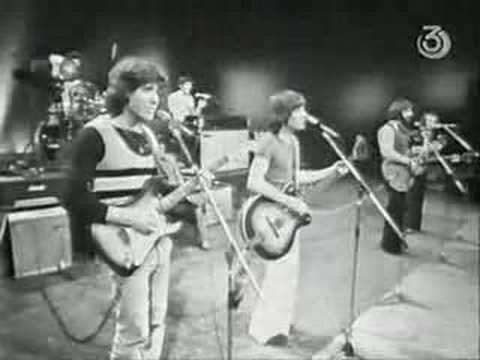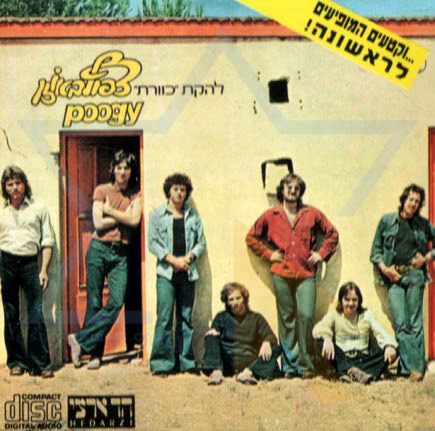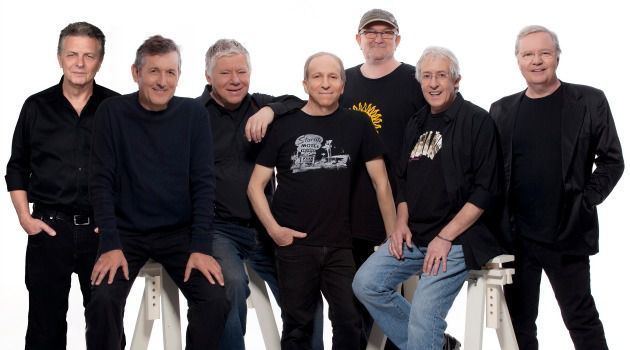
Sometimes a band is more than just a band. Sometimes a band can spearhead a cultural and social revolution in a country, and end up meaning more to the people in that country than foreigners could possibly understand from just listening to their recorded works. This is the story of such a band from Israel, usually referred to as Kaveret internationally.
There’s plenty to read about the band online, and many videos on YouTube, but how can users of the Latin alphabet be expected to find these things when the band spells their name as כוורת (in Hebrew writing)?
Fortunately there are options for the rest of us as well. While the direct translation of the Hebrew name is Beehive, the English version of their name is in fact Kaveret. To make things clear as mud, they also used the name Poogy (the drummer’s nickname) for their performances abroad. There’s no shortage of names surrounding this group, but after checking with those in the know, I am satisfied that it is most correct of me to refer to them as Kaveret.

The group consisted of a seven-piece collective of musicians and entertainers, who released three very successful albums during their active years from 1973 to 1976, with several live reappearances through the years. They are still beloved in their native Israel, where they won the title “Band of the Year” (by both Galei Tzahal and Israel Broadcasting Authority) four times in a row – unprecedented at the time and yet to be matched. The line-up included three guitars, bass, keyboards, drums and a vocalist with a tambourine. They played a great mix of progressive rock (often inspired by the British Canterbury scene, with bands like Camel and Caravan) with native influences. When they exploded onto the Israeli music scene, the impact was immediate and immense.
Their music is instantly fascinating to me just because it is rooted in different traditions and influences than those I normally hear. All band members come across as skilful and adventurous musicians and performers. The fact that everybody sang backing vocals gave them a rich, fabulous sound with lots of texture. The band’s technical proficiency is matched by their playfulness, resulting in an interesting mix of progressive rock, local/traditional music as well as influences harder to pinpoint.
All of this is ably demonstrated on one of their best tracks: Yo-Ya from their 1973 debut album.
Learning about this band has been fascinating, and I want to thank Ayelet Weiss Sackstein – honorary Israeli correspondent to the Norselands – for not just educating me on the band and their place in Israeli culture, but also providing a lot of the information contained in this text.
The historic context is important in understanding the cultural change and impact that Kaveret brought. Elvis Presley and The Beatles were huge phenomenas in the western world, bringing not just musical revolutions with them but social ones as well. Kaveret had a similar importance in their homeland. They were only active for some three years, but were catalysts on so many levels that they have never been forgotten.
Until the late 1960s, Israeli tunes were heavily based on Russian folk songs and French chansons. Mainstream music was in its greater part “mobilized” to nation-building efforts and often written with this in mind. The best known songs of those years were the ones sung by the numerous Army Troupes (there was one for every Corps), and being a veteran of such a troupe was the surest route to a successful stage career. A lot of the lyrics related to wartime, the love of the land, determination in the face of hardship, missing or grieving a loved one, etc. There were also light-hearted ditties purely meant to entertain, sometimes commissioned by the government to lift the nation’s spirit in times of particular hardship.
Western rock’n’roll in the 1960s was considered a bad influence and shunned by Israeli radio. In 1964, the Beatles were banned from performing in Israel because they were deemed to have “no artistic value, causing hysteria and riotous behavior among the youths.” These would-be riotous youths instead turned to a Jordanian radio station dubbed Radio Ramallah by its Israeli listeners, which shamelessly broadcast all the latest American and British hits. This influenced the formation of small rock scenes where local bands would play – mainly covers of international hits and not much original music. The first attempts at recording rock albums were made around 1968-69. The first successful one didn’t emerge until the early 70s.
The founding members of Kaveret served in the same army troupe, where they started performing together. When they were discharged, they formed a band. A certain Yitzchak Klepter (nicknamed Churchill; guitar) joined shortly after – a name I am quite familiar with!

As early as 1965, Klepter had formed a progressive rock band named The Churchills. It later evolved into an Anglo-Israeli group called Jericho Jones, which also included a few foreigners. They later shortened their name into Jericho. They put out one release under each of these three aliases, making it tricky to stay on top of them. Unlike Kaveret, the lyrics were all in English for these, with some international distribution. The classic release came under the Jericho Jones moniker, as Junkies Monkeys & Donkeys (1971) found an international audience. It is considered an underground progressive rock classic by many, including me, who discovered it when its cover art was featured in an old Record Collector calendar. I may need to look closer at the album on these pages at some later point. But, I digress.

Kaveret’s first album Poogy Tales was released in 1973. It was based on an earlier rock opera of the same name written by founding member Danny Sanderson, and went on to become one of Israel’s all time best selling albums. It was the first Israeli album recorded in a modern, high-quality studio (Triton), and also started their award-winning streak in style.
The songs are fun, filled with Lewis Carroll-style nonsense and literalization of metaphoric expressions. Serious topics are tackled with humour. There’s a lot of humour in the music too, and in their live shows the band emulated the army troupe formula by incorporating sketches. It worked!
Obviously, for someone not understanding the language, it is perhaps unavoidable that the spoken word sections on the album become the equivalent of dead air. Their significance was huge, and the important thing is that their core audience got it. The rest of us will just have to manage. The skits are in any case just spice, whereas the music is the main course.
This performance features both styles, as a skit bleeds into one of their better songs. (If the spoken part should get too much, skip ahead to the 4:15-mark.)
For the first time an Israeli rock band became so successful and loved that it actually released more than one album. Israel, struggling to recuperate from the Yom Kippur War of 1973, embraced their genial sarcasm and high-quality music, which ranged from the old-style Israeli songs to prog-rock and jazz.

The second album, Poogy In A Pita, was released in 1974.
It featured the track Natati La Khayay (I Gave Her My Life), which was the Israeli contribution to the Eurovision Song Contest that year. The contest was not yet considered an outright embarrassment where musical talent might get in the way of the show – it was still largely considered a valid artistic competition. The band considered it an honour to represent their country and turned in a fine performance, finishing 7th.
In hindsight, a 7th placement should be considered way above expectations for a show that still was predominantly west European in representation and style, and where orchestral arrangements meant everything.
Another (and, admittedly, better) track from their second album can be found in HaTmanum Ha’Itter (The Left Handed Octopus). This is a great live version recorded with the Israel Broadcasting Authority Arab Section Orchestra.

Their third and final studio album Crowded in the Ear (1975) was successful as far as sales, but actually received a lot of lukewarm reactions. Was it really that bad or was it backlash time? Over time the album still produced some much-loved tracks, but the band noted that the older material was more popular on the following tour and quietly revamped their setlist to feature more of their older material to please the crowd.
Still, the mood in the band seemed good at this time. On this track from 1975 they give each other a moment in the spotlight.
In early 1976 the band embarked on a U.S. tour, for which the band translated some of its repertoire to English and even demoed new songs in English. They spoke to many labels, but the material did not manage to get the band a record deal. They returned to Israel in June 1976 and resumed touring there, but they carried the disappointment with them which took out some of the joy and even led to tensions within the band. In the end they decided that doing other things would be healthier and jointly announced that the band had come to a natural end.
Kaveret has reunited repeatedly, performing live in 1984, 1989, 1998, 2000 and 2013. Here is an example of a latter-day performance from their 1998 reunion gig. The track Yo-Ya was a huge hit from their first album. An early performance was featured earlier in the text. Note how the song has grown since then, including an instrumental extravaganza starting after the second verse and chorus!
The final concert in 2013 was released on CD and DVD as “The Last Concert,” after which Kaveret disbanded permanently. The final show was a huge event with 50,000 people attending. Many were there with their children, and everyone knew every word – not just of the songs, but the sketches as well. You would expect nothing less for a band that has had such a big impact on the Israeli music and entertainment scene.


Facebook Comments